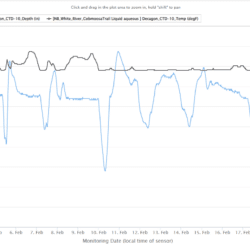Home › Forums › Environmental Sensors › Hydros 21 Depth/Conductivity During low temps
- This topic has 3 replies, 2 voices, and was last updated 2025-02-24 at 12:48 PM by
 neilh20.
neilh20.
-
AuthorPosts
-
-
2025-02-21 at 9:39 AM #18939
Hi All. We’ve been seeing some strange depth and conductivity trends at a few of our sites. Quick drops in depth over a short period of time with a quick bounceback. See attached screenshot example. This occurred on the same days at multiple sites on different streams, but in the same region. At one site, conductivity dropped a bit at the same time, but this hasn’t occurred at all sites where we’ve seen these depth fluctuations. At first we thought we were maybe seeing the results of ice dams building up then breaking. But on the ground reports state that the streams are not fully covered in ice, plus I’m not sure how that would explain the conductivity fluctuations. It seems that this happens during periods of particularly low temperature (lows in the single digits or negatives). My best guess is that there is some sort of fouling occurring. Perhaps small buildups of ice in or around the sensor, though it is confirmed that at least one of the sensors was not encased in ice when these fluctuations occurred. Curious to see if anyone else has seen similar occurrences or has any insights.
Attachments:
-
2025-02-21 at 3:19 PM #18941
I wonder what the water temperature is, or if there are water temperature changes, when this is happening.
From the graph it reads the water level is at 20″ depth then on the 10th Feb it drops by up to 5″ for some time (hours?) before recovering, with 3 other similar but not us pronounced events
IF any for of ice could build up in a pressure sensor it could change the readings, however at a water depth of 20″ that seems unlikely. As we know water is at its most dense at 4C, and ice forming at ~0C floats. It could be due to the hydrology that the water swirls and causes temperature fluctuations on the sensor – that’s why it would be interesting to have a reference to the sites, or have the temperature graph.
If there is a layer of ice, which you indicate there isn’t, and the water drops underneath the ice, the pressure on the sensor would change, which would indicate a real depth change.
Any temperature changes maybe key to artifacts in water depth readings – https://www.envirodiy.org/topic/artifactual-troughs-and-flickers-in-recorded-stream-depth/
-
2025-02-24 at 9:02 AM #18942
Thanks for your thoughts Neil.
These blips are occurring over the course of hours (roughly 4-6 hours from when depth starts dropping until it reaches it’s lowest point) though the time varies by occurrence.
They seem to be happening as temperature approaches the freezing point. I’ve attached a graph with temp for reference.
Attachments:
-
2025-02-24 at 12:48 PM #18947
Hi Jake, no “pressure sensor” is going to be able to be linear/accurate if ice is forming and expanding in the protective enclosure round the pressure sensor. My guess is the whole sensor would have to be specially designed to allow for the ice expansion to even survive a freezing event.
My hypothesis (guess) would be that its the nearly freezing is causing an artifact in depth reading. What is intriguing for that depth of water is that there are temperature variations of 4F between 3~5Feb. So unless you could observe the location and validate that there are real depth changes, its the sensor that is generating anomalous readings.
Then from the 10-21feb when the temperature line seems to flatten just at what looks like ~ 32.5?F Either the temperature sensor is failing, or you would be expecting ice to be forming on the surface. As its stream water – and ice formation is complex at round freezing seems
See annotated graph
Attachments:
-
-
AuthorPosts
- You must be logged in to reply to this topic.

 Welcome to EnviroDIY, a community for do-it-yourself environmental science and monitoring. EnviroDIY is part of
Welcome to EnviroDIY, a community for do-it-yourself environmental science and monitoring. EnviroDIY is part of 

